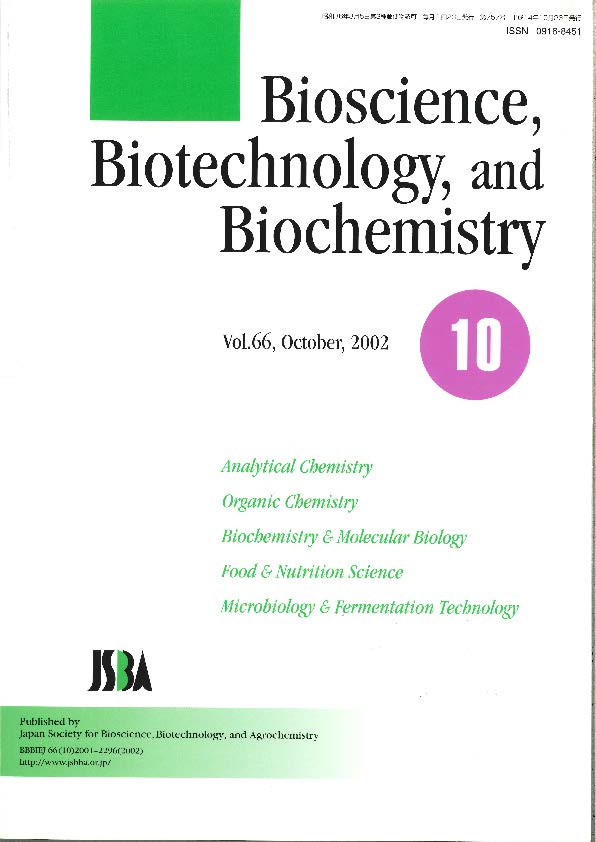Volume 66, Issue 10
Displaying 1-45 of 45 articles from this issue
- |<
- <
- 1
- >
- >|
Reviews
-
2002Volume 66Issue 10 Pages 2001-2016
Published: 2002
Released on J-STAGE: June 19, 2003
Download PDF (1427K) -
2002Volume 66Issue 10 Pages 2017-2029
Published: 2002
Released on J-STAGE: June 19, 2003
Download PDF (377K)
Analytical Chemistry Note
-
2002Volume 66Issue 10 Pages 2251-2255
Published: 2002
Released on J-STAGE: June 19, 2003
Download PDF (163K)
Organic Chemistry Regular Papers
-
2002Volume 66Issue 10 Pages 2090-2099
Published: 2002
Released on J-STAGE: June 19, 2003
Download PDF (530K) -
2002Volume 66Issue 10 Pages 2176-2182
Published: 2002
Released on J-STAGE: June 19, 2003
Download PDF (242K) -
2002Volume 66Issue 10 Pages 2236-2238
Published: 2002
Released on J-STAGE: June 19, 2003
Download PDF (156K)
Organic Chemistry Notes
-
2002Volume 66Issue 10 Pages 2243-2246
Published: 2002
Released on J-STAGE: June 19, 2003
Download PDF (161K) -
2002Volume 66Issue 10 Pages 2267-2272
Published: 2002
Released on J-STAGE: June 19, 2003
Download PDF (201K) -
2002Volume 66Issue 10 Pages 2273-2278
Published: 2002
Released on J-STAGE: June 19, 2003
Download PDF (216K)
Biochemistry & Molecular Biology Regular Papers
-
2002Volume 66Issue 10 Pages 2044-2051
Published: 2002
Released on J-STAGE: June 19, 2003
Download PDF (318K) -
2002Volume 66Issue 10 Pages 2060-2067
Published: 2002
Released on J-STAGE: June 19, 2003
Download PDF (291K) -
2002Volume 66Issue 10 Pages 2068-2076
Published: 2002
Released on J-STAGE: June 19, 2003
Download PDF (999K) -
2002Volume 66Issue 10 Pages 2083-2089
Published: 2002
Released on J-STAGE: June 19, 2003
Download PDF (1289K) -
2002Volume 66Issue 10 Pages 2107-2111
Published: 2002
Released on J-STAGE: June 19, 2003
Download PDF (492K) -
2002Volume 66Issue 10 Pages 2112-2124
Published: 2002
Released on J-STAGE: June 19, 2003
Download PDF (754K) -
2002Volume 66Issue 10 Pages 2125-2133
Published: 2002
Released on J-STAGE: June 19, 2003
Download PDF (1175K) -
2002Volume 66Issue 10 Pages 2134-2145
Published: 2002
Released on J-STAGE: June 19, 2003
Download PDF (709K) -
2002Volume 66Issue 10 Pages 2146-2153
Published: 2002
Released on J-STAGE: June 19, 2003
Download PDF (2999K) -
2002Volume 66Issue 10 Pages 2154-2160
Published: 2002
Released on J-STAGE: June 19, 2003
Download PDF (290K) -
2002Volume 66Issue 10 Pages 2183-2188
Published: 2002
Released on J-STAGE: June 19, 2003
Download PDF (588K) -
2002Volume 66Issue 10 Pages 2189-2193
Published: 2002
Released on J-STAGE: June 19, 2003
Download PDF (198K) -
2002Volume 66Issue 10 Pages 2194-2200
Published: 2002
Released on J-STAGE: June 19, 2003
Download PDF (943K)
Biochemistry & Molecular Biology Notes
-
2002Volume 66Issue 10 Pages 2224-2227
Published: 2002
Released on J-STAGE: June 19, 2003
Download PDF (1103K) -
2002Volume 66Issue 10 Pages 2239-2242
Published: 2002
Released on J-STAGE: June 19, 2003
Download PDF (1885K) -
2002Volume 66Issue 10 Pages 2256-2258
Published: 2002
Released on J-STAGE: June 19, 2003
Download PDF (1547K) -
2002Volume 66Issue 10 Pages 2264-2266
Published: 2002
Released on J-STAGE: June 19, 2003
Download PDF (1693K) -
2002Volume 66Issue 10 Pages 2279-2282
Published: 2002
Released on J-STAGE: June 19, 2003
Download PDF (393K) -
2002Volume 66Issue 10 Pages 2287-2291
Published: 2002
Released on J-STAGE: June 19, 2003
Download PDF (438K)
Biochemistry & Molecular Biology Preliminary Communication
-
2002Volume 66Issue 10 Pages 2292-2296
Published: 2002
Released on J-STAGE: June 19, 2003
Download PDF (838K)
Food & Nutrition Science Regular Papers
-
2002Volume 66Issue 10 Pages 2036-2043
Published: 2002
Released on J-STAGE: June 19, 2003
Download PDF (210K) -
2002Volume 66Issue 10 Pages 2077-2082
Published: 2002
Released on J-STAGE: June 19, 2003
Download PDF (296K)
Food & Nutrition Science Notes
-
2002Volume 66Issue 10 Pages 2221-2223
Published: 2002
Released on J-STAGE: June 19, 2003
Download PDF (141K) -
2002Volume 66Issue 10 Pages 2228-2231
Published: 2002
Released on J-STAGE: June 19, 2003
Download PDF (614K) -
2002Volume 66Issue 10 Pages 2232-2235
Published: 2002
Released on J-STAGE: June 19, 2003
Download PDF (156K) -
2002Volume 66Issue 10 Pages 2247-2250
Published: 2002
Released on J-STAGE: June 19, 2003
Download PDF (587K)
Microbiology & Fermentation Technology Regular Papers
-
2002Volume 66Issue 10 Pages 2030-2035
Published: 2002
Released on J-STAGE: June 19, 2003
Download PDF (220K) -
2002Volume 66Issue 10 Pages 2052-2059
Published: 2002
Released on J-STAGE: June 19, 2003
Download PDF (627K) -
2002Volume 66Issue 10 Pages 2100-2106
Published: 2002
Released on J-STAGE: June 19, 2003
Download PDF (241K) -
2002Volume 66Issue 10 Pages 2161-2167
Published: 2002
Released on J-STAGE: June 19, 2003
Download PDF (254K) -
2002Volume 66Issue 10 Pages 2168-2175
Published: 2002
Released on J-STAGE: June 19, 2003
Download PDF (1713K) -
2002Volume 66Issue 10 Pages 2201-2208
Published: 2002
Released on J-STAGE: June 19, 2003
Download PDF (1542K) -
2002Volume 66Issue 10 Pages 2209-2215
Published: 2002
Released on J-STAGE: June 19, 2003
Download PDF (1534K) -
2002Volume 66Issue 10 Pages 2216-2220
Published: 2002
Released on J-STAGE: June 19, 2003
Download PDF (651K)
Microbiology & Fermentation Technology Notes
-
2002Volume 66Issue 10 Pages 2259-2263
Published: 2002
Released on J-STAGE: June 19, 2003
Download PDF (1911K) -
2002Volume 66Issue 10 Pages 2283-2286
Published: 2002
Released on J-STAGE: June 19, 2003
Download PDF (259K)
- |<
- <
- 1
- >
- >|
